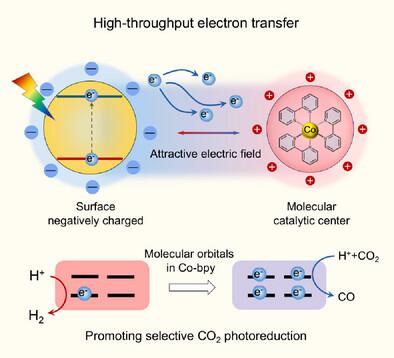无机-有机界面电场中的高通量电子转移使CO2选择性光还原
IF 16.9
1区 化学
Q1 CHEMISTRY, MULTIDISCIPLINARY
引用次数: 0
摘要
长期以来,光催化CO2还原的效率一直受到H2演化反应的限制。在这项研究中,我们提出了一种创新的策略来促进高通量电子转移来抑制H2的演化,从而增强CO2的还原。通过使用cd和联吡啶钴作为模型,我们设计了cd的表面,在无机-有机界面处产生电场。通过原位和瞬态光谱技术,我们发现,与那些与─NH2基团功能化的CdS相比,与COOH基团功能化的CdS表现出显著的非共价相互作用和改进的电荷转移能力。电子在联吡啶钴上的快速传递有利于吸附的CO2参与质子-电子耦合反应,而不是让被吸附的质子直接接受电子。结果表明,所建立的CdS-COOH/Co(II)-bpy体系Co产率为2.523 mmol g−1 h−1,选择性为96.3%。本研究提出了一种创建高效电荷传输界面的方法,并为设计高性能光催化CO2还原系统提供了一种全面的策略,该系统可以有效地抵消竞争性H2演化反应带来的挑战。本文章由计算机程序翻译,如有差异,请以英文原文为准。

High-Throughput Electron Transfer in Inorganic–Organic Interfacial Electric Field Enabling Selective CO2 Photoreduction
The efficiency of photocatalytic CO2 reduction has long been limited by the competing H2 evolution reaction. In this study, we present an innovative strategy for boosting high-throughput electron transfer to suppress H2 evolution, thereby enhancing CO2 reduction. By employing CdS and cobalt bipyridine as a model, we engineered the surface of CdS to create an electric field at the inorganic–organic interface. Through in situ and transient spectroscopy techniques, we discovered that CdS functionalized with ─COOH groups demonstrates remarkable noncovalent interactions and improved charge transfer capabilities compared to those functionalized with ─NH2 groups. The fast delivery of electrons on cobalt bipyridine facilitates the adsorbed CO2 to participate in the proton-electron coupling reaction, rather than allowing adsorbed protons to accept electrons directly. Consequently, the established CdS-COOH/Co(II)-bpy system achieved a CO production rate of 2.523 mmol g−1 h−1 with a selectivity of 96.3%. This research presents an approach for creating efficient charge transport interfaces and provides a comprehensive strategy for designing high-performance photocatalytic CO2 reduction systems that effectively counteract the challenges posed by competing H2 evolution reactions.
求助全文
通过发布文献求助,成功后即可免费获取论文全文。
去求助
来源期刊
CiteScore
26.60
自引率
6.60%
发文量
3549
审稿时长
1.5 months
期刊介绍:
Angewandte Chemie, a journal of the German Chemical Society (GDCh), maintains a leading position among scholarly journals in general chemistry with an impressive Impact Factor of 16.6 (2022 Journal Citation Reports, Clarivate, 2023). Published weekly in a reader-friendly format, it features new articles almost every day. Established in 1887, Angewandte Chemie is a prominent chemistry journal, offering a dynamic blend of Review-type articles, Highlights, Communications, and Research Articles on a weekly basis, making it unique in the field.

 求助内容:
求助内容: 应助结果提醒方式:
应助结果提醒方式:


